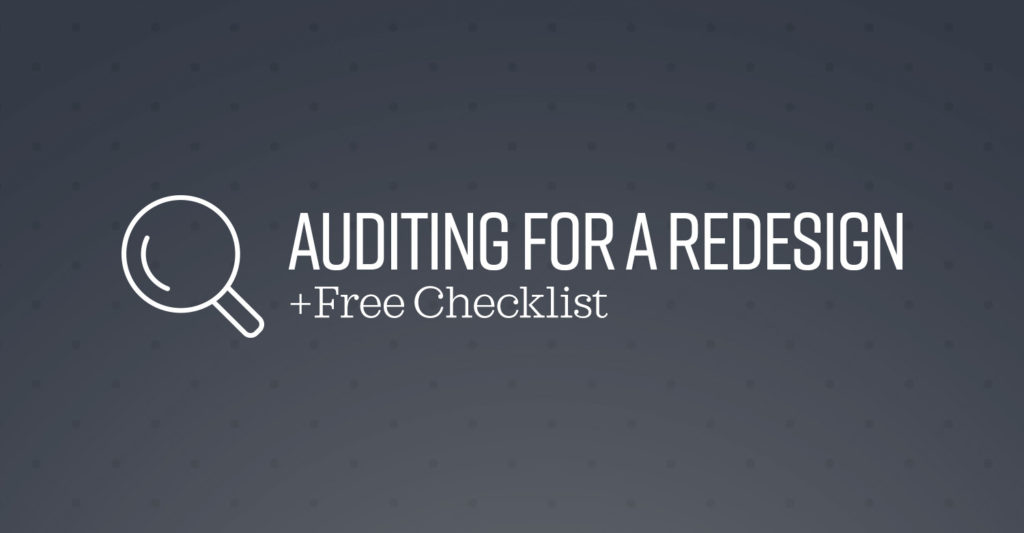If you’re thinking of doing a website redesign, you probably have an inkling that there is something about your current website that is not quite working for you.

Whether you’re wanting to reorganize and update current content, work to improve your search ranking through SEO or just want a fresh redesign, a website audit is a great way to begin the process of figuring out what elements are amiss and how to right the ship.
An audit is also a good way to evaluate the effectiveness of your site overall and its marketing message, while helping you set goals and analytical data points to revisit after relaunch to gauge success.
Additionally, being able to point out specific areas that need improvement will give you an advantage when trying to convince the higher-ups to give you the go-ahead.
Here are our tips, and a handy checklist, to help you audit your website for the new year.
Have A Plan
Before you begin auditing your website, have a plan in place for what you are trying to accomplish.
Go back to the foundation of your organization, and think about the message you want to send to your audience.
Since most websites are the main source of information for an organization, it should quickly convey the following:
1. Who you are.
2. What you do.
3. How you differentiate yourself from other similar organizations or companies
4. Who you want to reach
5. Strong sense of your company’s character.
By nailing down this information early on, the groundwork for your new website will be set and you can focus on the top priorities.
Website Audit

When you are ready to review your current website, set the criteria on which your evaluation will be based.
The most common elements for an audit include design style, ease of management, content quality, organization of content, SEO, ADA accessibility and overall usability.
Overall Design
For some organizations, design is the most important factor; they just feel like their current site is dated. For others, design is a small concern, focusing instead on the messaging and organization of content.
As you review your website, what does your design say? Does it present your brand in the proper light? Does it match your marketing materials? Do the photo choices stand out or look like generic stock?
Bonus: Here are our predictions for 2017 Website Design Trends to watch for.
Ease of Management
Websites have to be updated to be successful. No one, including Google, likes a website that’s outdated.
Does your current website use a content management system, such as WordPress or Drupal, or is it all hand coded?
Over 25% of the web is powered by WordPress, making it the number one choice for content management. This also means many tutorials and guides exist to help you use it to its fullest power.
Content and Organization
Along with design, content and messaging are important to funneling prospects to the right parts of your website. Does your content still reflect your organization, its goals and mission?
If not, it’s time to update it! Remember, most people have short attention spans, so content should be short, focusing on actionable details and not “puffery.” Talk about how you can truly help and what makes you unique, showcasing your organization and how it stands out.
Also consider how the content is organized.
Through Google Analytics, or other similar tools, you can see how visitors flow through and interact with content on your website, helping you best format it for readability.
Do you need 20 pages, or will 5 suffice? Analytics will help you determine what’s actually read and for how long.
SEO
Search engine optimization is one of the most complicated pieces of the website puzzle, especially since it’s constantly changing. In any redesign, SEO should be an important factor, regardless of your size or location.
Focus on making sure your content is found.
Search marketing has its own ins-and-outs. We recommend checking out this Local SEO Checklist from Moz for more information and details on some of the best steps to auditing your website’s SEO.
ADA Accessibility
In addition to a general audit, many non-profits and businesses choose to conduct a web accessibility audit, evaluating how well a site supports users with disabilities.
Section 508 of the Rehabilitation Act of 1973 states that agencies must provide employees with disabilities and the public access to information that is comparable to access available to others.
A complete audit reviews how the website functions on special adaptive devices, such as screen readers, and helps you understand how people use the website. Simple things, like headings, usually have to be updated for ADA accessibility, along with adding alternate descriptions or captions on imagery.
Making sure that your website is ADA compliant will only prove to boost web user satisfaction.
Wrapping Up
It is important to consider all these factors seriously in order to gain insight into any current shortcomings of your website.
Ultimately, the insight you gain from a web audit will give way to new ideas and strategies on how to improve user experience. It will work to your advantage when it comes to increasing web traffic and return on investment (ROI).
Download Our Free Checklist Guide:

